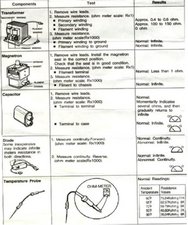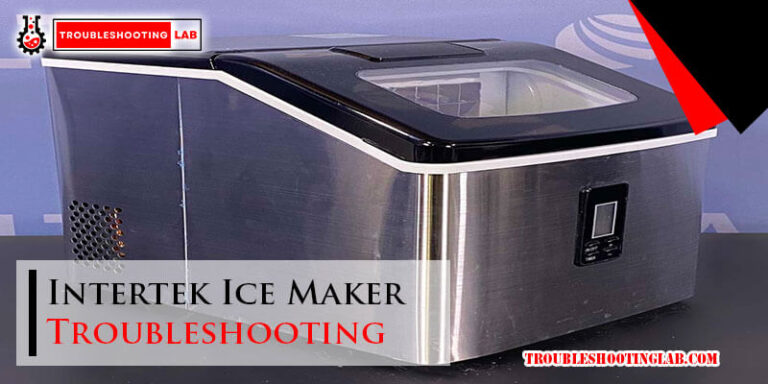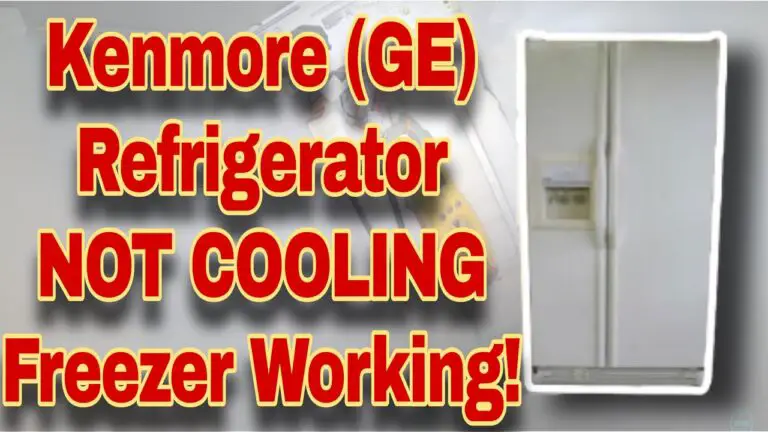Ge Microwave Not Heating Troubleshooting: Quick Fixes
Is your GE microwave giving you trouble by not heating your food? You’re not alone.
Few things are more frustrating than expecting a hot meal and being met with cold disappointment. But don’t worry—this issue doesn’t always mean it’s time to replace your microwave. In fact, many common problems can be fixed with a little troubleshooting.
In this guide, we’ll walk you through the most likely reasons your GE microwave isn’t heating and how you can potentially solve the problem yourself. Whether it’s a simple fix or a sign of something more serious, you’ll learn exactly what to do next. Keep reading to save time, money, and the hassle of guessing what’s wrong with your microwave. Let’s get started!
Common Causes Of Heating Issues
When your GE microwave suddenly stops heating, it can feel like your kitchen routine hits a wall. The good news? Many heating issues come down to common, fixable causes. Let’s break them down so you can troubleshoot with confidence and get your microwave back in action.
Faulty Magnetron
The magnetron is the heart of your microwave’s heating system. If it’s burnt out, your food won’t heat, no matter how long you set the timer. A telltale sign of a bad magnetron is a buzzing noise during operation.
Replacing a magnetron is a complex task that often requires professional help. But before jumping to conclusions, check other components first, as a magnetron failure is less common than you might think.
Burnt Diode
A burnt diode can prevent your microwave from generating the high voltage needed to heat food. If your microwave turns on but doesn’t heat, this is a likely culprit.
Test the diode with a multimeter to confirm if it’s faulty. If the diode is damaged, you’ll need to replace it. Thankfully, diodes are relatively inexpensive and easy to find online or at appliance stores.
Malfunctioning Door Switch
Did you know that your microwave won’t heat if the door doesn’t latch properly? A malfunctioning door switch can trick your microwave into thinking the door is open, even when it’s closed.
Listen for the “click” sound when you close the door. If the sound is missing or the microwave doesn’t start, inspect the door switch for wear and tear.
Blown Thermal Fuse
The thermal fuse acts as a safety mechanism, cutting power to the microwave if it overheats. If the fuse blows, your microwave might power on but fail to heat.
Check the fuse using a multimeter. If it’s blown, replace it with a new one. Always use a fuse with the same rating to avoid further issues.
Power Supply Problems
Sometimes, the issue isn’t within the microwave but the power supply. If the outlet isn’t providing sufficient voltage, your microwave won’t function properly.
Plug another appliance into the same outlet to test it. Alternatively, try using a different outlet to rule out power supply issues.
By addressing these common causes one step at a time, you’ll save yourself the frustration of unnecessary repairs. Which of these issues do you think might be causing your microwave to act up? Start small, and don’t hesitate to call an expert if needed!

Credit: www.ifixit.com
Preliminary Checks To Perform
If your GE microwave isn’t heating, start with simple checks. These steps can save time and avoid unnecessary repairs. Ensuring the microwave has proper power and no mechanical issues is crucial.
Inspect The Power Source
Ensure the microwave is plugged into a working outlet. Test the outlet with another device to confirm it’s supplying power. Inspect the power cord for visible damage or wear. A faulty cord can interrupt the power supply.
Check if the circuit breaker is tripped. Reset it if necessary. Overloaded circuits can prevent the microwave from working properly.
Verify The Door Is Fully Closed
Microwaves won’t operate if the door isn’t securely closed. Inspect the door for obstructions or debris preventing it from shutting completely. Look for damage to the door latch or hinges that might interfere with closure.
Ensure the door seals are intact. Faulty seals can stop the microwave from functioning safely.
Check For Error Codes
Modern GE microwaves display error codes for specific issues. Check the microwave’s screen for any codes. Refer to the user manual to understand their meaning. These codes can indicate problems like overheating or sensor malfunctions.
Reset the microwave by unplugging it for a few minutes. This can clear temporary errors.
`Diy Fixes For Common Problems
If your GE microwave isn’t heating food, it can feel frustrating. But before calling a technician, you might be able to fix the issue yourself. Let’s walk through some common DIY fixes that could save you time and money.
Resetting The Microwave
A simple reset can solve many microwave problems, including heating issues. Unplug your microwave from the outlet and wait for about 5 minutes. Plug it back in and test it—sometimes, this is all it takes to clear minor glitches in the system.
Don’t skip this step, even if it feels too basic. Electrical appliances can behave unpredictably, and a reset acts as a quick refresh. If the microwave still doesn’t heat, move on to the next step.
Testing The Door Switch
The door switch ensures the microwave operates only when the door is closed. A faulty switch can prevent the microwave from heating. You can test this by closing and reopening the door firmly to see if it engages properly.
If that doesn’t work, use a multimeter to check the continuity of the switch. No continuity? The switch may need replacing. You can easily find replacement parts online or at your local hardware store.
Replacing The Fuse
A blown fuse is a common reason why a microwave stops heating. First, unplug the microwave and locate the fuse compartment—usually behind the control panel or near the power cord. Carefully remove the fuse and inspect it for signs of damage like burn marks or a broken filament.
If it’s damaged, replace it with a fuse of the same rating (this is crucial for safety). After replacing the fuse, test the microwave to see if it’s back to working condition. Still no heating? Keep troubleshooting.
Inspecting And Cleaning The Magnetron
The magnetron is the component that produces the heat in your microwave. Over time, it can accumulate dirt or become faulty. Before assuming the worst, check for visible debris or food particles around the magnetron area.
Clean it gently using a damp cloth, ensuring the microwave is unplugged during this process. If cleaning doesn’t fix the problem, the magnetron may need replacement—a task better suited for professionals. But at least you’ve ruled out simple causes.
What’s next on your troubleshooting journey? If none of these fixes work, it may be time to call a technician. But pat yourself on the back for trying—you’ve likely saved yourself a diagnostic fee already!

Credit: www.wikihow.com
When To Seek Professional Help
Sometimes, fixing a GE microwave that isn’t heating can be tricky. While basic troubleshooting can address minor issues, some problems require professional expertise. Knowing when to step back and call a technician is crucial. This ensures your safety and prevents further damage to your appliance. Below are key scenarios where expert help is necessary.
Signs Of Complex Electrical Issues
Electrical problems can be hard to diagnose without proper tools. If your microwave trips the circuit breaker frequently, it’s a red flag. Other signs include unusual noises or flickering lights during operation. These issues often stem from faulty wiring or internal electrical components. A professional can safely inspect and repair these problems.
High-cost Component Failures
The magnetron is the heart of your microwave’s heating system. If it fails, your microwave won’t heat food at all. Replacing a magnetron is costly and requires specialized knowledge. Other parts like the high-voltage capacitor or transformer can also fail. Attempting these repairs on your own can be dangerous and expensive if done incorrectly. A trained technician has the skills to handle such tasks.
Safety Concerns With Diy Repairs
Microwaves store high voltage even after being unplugged. This can pose serious safety risks during DIY repairs. Mishandling internal components can lead to electric shocks or further appliance damage. Professionals are trained to work safely with high-voltage devices. Trusting an expert ensures your repair is done without unnecessary risks.
Tips To Prevent Future Issues
Preventing future issues with your GE microwave is crucial for long-term functionality. Taking simple precautions can help you avoid costly repairs. These tips focus on care and maintenance to keep your microwave working efficiently.
Avoid Overloading The Microwave
Overloading your microwave can strain its internal components. Use appropriate-sized dishes to avoid crowding the interior. Large or heavy items can block heat distribution, leading to uneven cooking. Always check the microwave’s capacity before heating food.
Regular Cleaning And Maintenance
Clean your microwave regularly to prevent food buildup. Residue can block vents and affect heating performance. Wipe the interior and exterior with a damp cloth after use. Inspect the door seal for damage or debris to ensure proper closure.
Using Approved Microwave-safe Containers
Non-microwave-safe containers can damage the microwave or release harmful chemicals. Always check for labels indicating microwave safety on your dishes. Avoid using metal or plastic not designed for microwave use. Approved containers ensure safe and consistent heating.

Credit: www.youtube.com
Conclusion
Fixing a GE microwave that’s not heating can feel overwhelming. Start by checking common issues like power supply, door switches, and settings. Regular maintenance and proper use help prevent problems. If troubleshooting doesn’t work, professional repair may be necessary. Ignoring the issue might lead to bigger problems later.
Always prioritize safety when dealing with electrical appliances. A well-functioning microwave saves time and effort in the kitchen. Keep your microwave in good condition for reliable performance.






